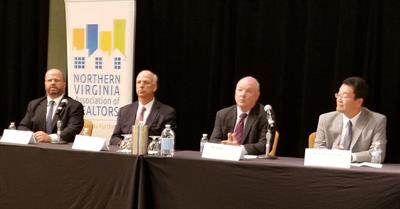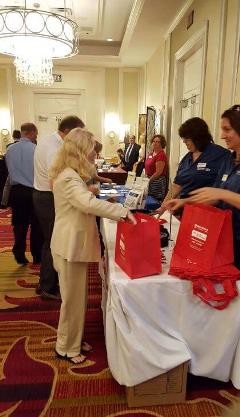2017 NVAR ECONOMIC SUMMIT SPEAKERS EXPLORE COMMERCE, INVENTORY, TRANSPORTATION CHALLENGES
LISTENING TO THE PANELISTS at the 2017 NVAR Economic Summit, one might conclude that Northern Virginia is a victim of its own success. With shortfalls of affordable housing stock, skilled IT workers and viable transportation options, the region faces challenges in its continuing quest to retain its title as the “Silicon Valley of the East.”

Pictured here (left-right), summit presenters took questions from the moderator and the audience: Supervisor Martin Nohe, chairman of the Northern Virginia Technology Council; Dr. Jerry Gordon, president and CEO of the Fairfax County Economic Development Authority; Dr. Terry Clower, director of the George Mason University Center for Regional Analysis; and Dr. Lawrence Yun, chief economist and senior vice president of research for the National Association of Realtors®.
THE NATIONAL OUTLOOK
Opening the September 18 Summit with an analysis of how national economic
trends impact the local Northern Virginia market, National Association of Realtors® Chief Economist Lawrence Yun drilled down on interest rates, demand and potential challenges to the mortgage interest deduction.
Yun noted an immediate increase in mortgage interest rates following the U.S. presidential election one year ago, which came as a surprise to some economists. Whether fueled by the prospect of a better economic picture with a pro- business leader, or by the anticipation of a worsening budget deficit, the result was a higher cost to borrow for homebuyers. However, mortgage rates remain comparatively low from a historical perspective, and nationwide home sales are higher compared with the 12 months prior, Yun explained.
Post-election, consumer confidence grew, according to NAR survey results, with respondents believing it was a good time to buy a home. The problem, Yun said, is one of too many buyers and not enough inventory. Builders are not building enough, Yun noted. “We have a shortage of lots, labor, lending and lumber.”
Despite a continued consumer belief in homeownership as the “American Dream,” the homeownership rate is at a 50-year low, pointing to a pent-up housing demand, Yun said. “There are 6.9 million missing households,” Yun said. “Young adults, aged 25-34 are living with their parents, therefore not creating housing demand.”
Yun’s housing market outlook for 2018: an increase in prices due to low inventory and overall improvement in total sales.
NORTHERN VIRGINIA’S STRENGTHS, CHALLENGES
The number one thing about the region’s economy, said Dr. Terry Clower, chairman of the George Mason University Center for Regional Analysis: “I’m surprised by the strength in our job growth.”
Even with lower federal procurement spending, our economy is still growing, Clower said. We’re creating Professional and Business Services jobs, which are “pretty high paying,” he noted.
“Unemployment is not a problem,” Clower said. This doesn’t mean that everyone has the job they want, however. “A substantial number are underemployed.”
Northern Virginia is faced with the problem of outmigration, Clower said. More people have chosen to leave the region than to come in. “We’re trying to understand why,” he said. “Are key workforce people leaving for a lower cost of living?” Clower suggested that Realtors® may be well positioned to learn the answer to this question.
A lack of inventory is the real challenge for this region, Clower said, echoing Yun’s assessment. “We’re continuing to under- produce housing in this market.”
“A lack of inventory is the real challenge for this region, Clower said, echoing Yun’s assessment. “We’re continuing to under- produce housing in this market.”

COMMERCIAL DEVELOPMENT AND DIVERSIFICATION: KEYS TO REGIONAL GROWTH
We must have growth in the business community to offset the cost of services to residents,” said Dr. Jerry Gordon, president and CEO of the Fairfax County Economic Development Authority. With such a dramatic population growth, comes an increase in public works—schools, roads, safety, libraries, he explained.
Virginia provides public services on the basis of income taxes, Gordon noted. “44 percent of all income tax in Virginia comes from Northern Virginia,” he said. “Just shy of 25 percent comes from Fairfax County alone.” These funds are distributed throughout the state, with just 19 cents of every dollar available to the county for programs and services, Gordon explained.
Emphasizing the importance of commercial development, Gordon said, “64 percent of all Country expenses [are funded by] real estate taxes.” There are two parts to the real estate tax: commercial and residential, Gordon said. “Residents take back more in services than they pay in taxes—$1.60 for every $1.00 paid; businesses take back around $.35 for each $1.00 paid.”
The good news, Gordon noted, is that Fairfax County has grown to have the second largest volume of suburban commercial space in the U.S., behind Orange County, California. The bad news, he said, is that of the 120 million sq. ft. of available office space, 18 million sq. ft. is vacant – all of the tax burden is on owners, and can’t be passed through to tenants.
The challenge for FCEDA: fill that office space! The county is pursuing new opportunities that include companies providing IT, including cyber-security, data analytics and cloud computing; software development; translational medicine; and telecommunications.
“One of the greatest flaws we have is that we don’t have enough IT [Information Technology] workers,” Gordon said. “You’re golden if you have those skills. And you’re golden if you have a security clearance.”
“Diversity is important,” Gordon emphasized. The Fairfax County population is 48 percent minority, he said. Residents come because they want a diverse community, and businesses appreciate the many different problem-solving perspectives that a diverse workforce brings, he noted.
And surprisingly, Gordon said, compared to our top competing regions, homes in Northern Virginia are actually more affordable, and traffic is less congested!
BUSTING THE REGIONAL BOTTLENECK
“Northern Virginians talk about traffic the way people in other parts of the country talk about the weather,” said the Honorable Martin Nohe, chairman of the Northern Virginia Transportation Authority and a member of the Prince William County Board of Supervisors.
Speaking about the number one complaint of many Northern Virginia residents, Nohe said, “The biggest challenge we have is that we don’t have enough options.” While there are many transportation systems in the region, they aren’t networked, Nohe said.
A significant roadblock to improving the region’s transportation woes is convincing nine governing bodies to work together, Nohe explained. “Intra-regional transportation has become a bigger challenge than before,” Nohe explained. A regional plan would need to address seven major corridors.
“How can we deliver congestion solutions and target regions where people are most in need of help,” Nohe asked. There are 358 projects that have been identified, which would cost $44.1B, Nohe said. The catch:
“I don’t have $44.1B.”
The region has $300M earmarked annual for Northern Virginia as a result of legislation passed during the McDonnell Administration. The NVTA staff is tasked with determining how to spend those funds. And the bottom line, Nohe said: “If we build everything, things get marginally better, but not good.”
Involvement in an organization like NVAR is valuable not just for a Realtor’s® business, but also for the region, Nohe said to the audience of real estate professionals.
“If you’re not talking about transportation in Northern Virginia, you’re not talking about making Northern Virginia a better place,” Nohe concluded.
To view the speakers’ PowerPoints, visit nvar.com/presentations.